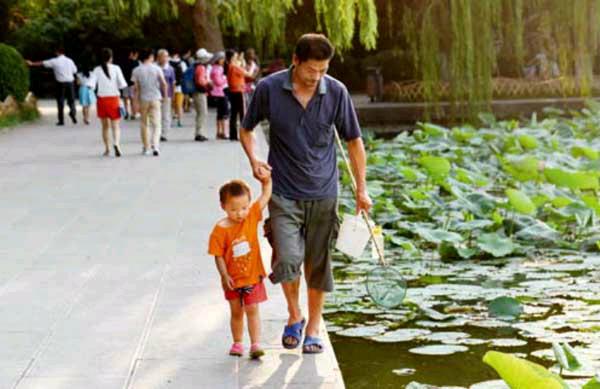Eternal Springs of Jinan
by+Cecile+Zehnacker

I was invited to Jinan, the capital of Shandong Province, to participate in a photo event associated with the restoration of Baihuazhou area, an ancient block that has recently been renovated into a scenic spot showcasing intangible culture heritage and traditional cultural activities. Baihuazhou, which literally means “Hundred Flower Pond,” refers to the artificial pond south of Daming Lake in the Lixia District of Jinan Old City that stands right next to this block. It is part of the same water flow as the Daming Lake. Qushuiting Street, situated along Baihuazhou and following the course of Qushui stream, stretches to Daming Lake, passing the Fuxue Confucius Temple and Baihuazhou Pond.
The Baihuazhou area is a great place to visit. The stunning renovated block that stands behind the pond hearkens to ancient life in China. The block is composed of several small and big courtyards with small ponds surrounded by beautiful buildings. Some buildings exhibit items that were collected over the years and preserve the history of the city. Others demonstrate ancient traditional activities like paper making. In the past, the ponds served as the main water supply for local residents.
The area around Baihuazhou is also full of places just waiting to be discovered. Its blood pumps through quiet little alleys where local life happens. At some point we stumbled upon a surprise: a natural swimming pool surrounded by buildings. Jinan is so famous for springs, and it is known as the “City of Springs.” The springs of Jinan have made the city popular year-round
since ancient times. The water temperature never drops below 18 degrees Celsius. The“palace pool,” as its known, is a destination for both swimming and exercise. The stunningly blue water is crystal clear, making the temptation to take a quick dip hard to resist. Its Chinese name “Zhouying”meaning “washing out the tassel” comes from a poem written by Mencius, the second most famous Chinese philosopher after Confucius. Like Confucius, Mencius was also born in Shandong Province, considered the cradle of Confucianism.
The springs that made the city famous nationwide can be found throughout Jinan. They are divided into four groups. The first, the Baotu Springs group, stands out due to its abundance. To access it we took a traditional boat ride through the water- ways of the city and arrived directly in the charming park of Baotu Springs, which features several temples and pavilions. According to legend, Emperor Qianglong of Qing Dynasty (1644-1911) took some water from Beijings Jade Spring on his way to the southern Yangtze River, and drank from Baotu Spring during a stopover in Jinan. He highly favored the latter and dubbed it “number one spring under heaven.” Although we werent lucky enough to witness it, at times, the water bubbles, delighting visitors. The entire park is beloved by the locals for its beauty and serenity.
Black Tiger Springs group, located in southeastern Jinan Old City, has the second heaviest water flow after Baotu. The sound of the water resembles a tigers roar, and three of its ponds are shaped like tigers.
Pearl Springs group is located in the center of Jinan Old City and is the primary water source of Daming Lake. Finally, Five Dragon Pool Springs group has a very deep pool, and in years past when a drought struck, residents would pray for water and rain would come.
Daming Lake, one of the most beautiful places in Jinan, has one entrance facing Baihuazhou. It is reminiscent of West Lake in Hangzhou. Luckily enough, our trip happened to coincide with lotus season, and magnificent lotuses were blossoming on the surface of the lake. Its water is supplied by the citys springs and empties into the Yellow River. The 58-hectare lake covers half of the park and makes a great place to stroll or take a boat ride. A unique feature of Daming Lake, also called “The Lake of Great Light,” is that its level remains constant year-round, and flooding and droughts never affect it.
Daming Lake is considered one of the three must see places in Jinan along with Baotu Springs and Thousand-Buddha Mountain. Thousand-Buddha Mountain lies in the southern outskirts of the city, amidst the mountains that surround Jinan. Its history can be traced as far back as the Sui Dynasty (581-618), when Buddha images carvings began appearing on Mount Li, which became Thousand-Buddha Mountain. The carvings were followed by the construction of a temple named after the mountain. It has been famous for ages, and 130 Buddha statues dating back to the Sui Dynasty remain there today.
With so many interesting and beautiful places to visit, Jinan is definitely worth discovering, even though it usually misses lists of places to visit in China. And its only a 1.5-hour train trip from Beijing, making it a good starting point to continue exploring the region, especially places like Qufu City (south of Jinan, about 35 minutes by train), the hometown of Confucius, Taishan Mountain(south of Jinan, about 20 minutes by train to Taian), one of the five sacred mountains of Taoism, and Weifang (northeast of Jinan, two hours by train), the city of kites.

